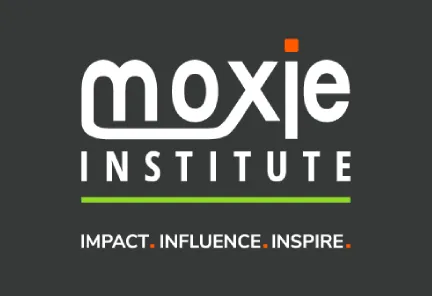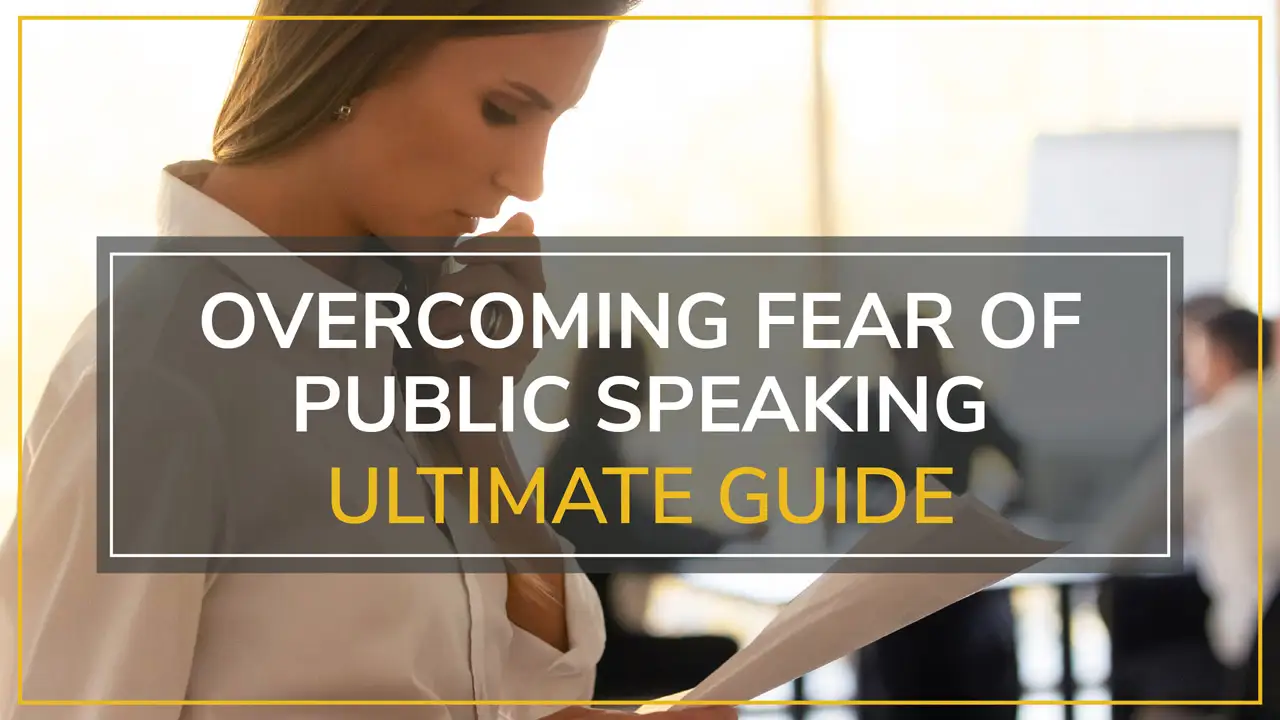Introduction: Transform Pre-Presentation Anxiety into Power
Can you relate to that feeling when you still have 5 minutes before your presentation starts, yet your heart is beating, your palms are sweaty, and your head feels like it’s about to explode? You’re not alone. Public speaking anxiety is said to be the number one anxiety for about 73 percent of people.
But what if you could turn all that nervous energy into laser-like focus—all in just five minutes? What if you had a science-based recipe to consistently shift you from anxiety to confidence seconds before you stand up to speak?
Here at Moxie Institute, we created The FIA Method—a quick 5-minute pre-presentation ritual grounded in science, performance psychology, and drawing from our experience having trained thousands in our presentation skills training programs. This approach has enabled practitioners from all sectors to turn pre-presentation nerves into confident, connecting presence.
In this ultimate guide to how to prepare for a presentation, we’ll explain each of the three elements of the FIA Method—Focus, Intention, and Activation—through strategies you can apply in any field, whether you’re in charge of making a boardroom presentation or you’re delivering a keynote speech. Whether you’re a seasoned speaker who is hoping to optimize your pre-presentation ritual, or someone who gets crippling presentation jitters, mastering this 5-minute routine will help you take any stage with clarity, intention, and confidence.
Understanding Presentation Anxiety: The Science Behind the Nerves
Before we get into the FIA Method, it’s helpful to know what exactly is going on in the brain and body when presentation anxiety hits. This is because knowledge is power: once you understand the forces behind your anxiety, it allows you to deal with it strategically, rather than just trying to “push through” or “calm down.”
The Physiological Response
When you think about speaking in public, your brain’s amygdala (the threat-detection center) can easily activate the sympathetic nervous system’s “fight-or-flight” response. This evolutionary process, which has evolved to keep you safe from physical threats, triggers a chain reaction of physical changes:
- Racing heart and high blood pressure
- Shallow, rapid breathing
- Production of stress hormones (cortisol and adrenaline)
- Shunting of blood from digestion to muscle systems
- Perspiration to protect the body from overheating during vigorous activity
- Dry mouth (because you do not salivate as much when you are under stress)
Research published in the Journal of Cognitive Neuroscience suggests this physical reaction can start 24 hours before the presentation but tends to peak in intensity in the 15 to 30 minutes leading up to it.
The Psychological Impact
In addition to the physiological symptoms, presentation anxiety results in several cognitive reactions:
- Increased levels of self-focus and self-consciousness
- Racing thoughts and difficulty concentrating
- Catastrophic thinking (“I’m going to totally blow it”)
- Loss of memory (forgetting what you’ve memorized)
- Increased fear of how you will be perceived and judged by your audience
- Distortion of time (rushing or “spacing out”)
In our work with thousands of professionals and through our comprehensive presentation coaching sessions, we’ve discovered that many times it’s not so much the actual physiological symptoms as it is how people are interpreting those symptoms that determines performance quality. People who interpret their heart racing and accelerated breathing as “excitement” instead of “anxiety” always do better.
According to the pioneering research conducted by Harvard Business School’s Alison Wood Brooks in the Journal of Experimental Psychology, merely reinterpreting anxiety as excitement enhanced public speaking performance by anywhere from 17-33%. This truth is a core concept behind the FIA Method: we don’t seek to stop the physiological response, but rather to re-channel and utilize it.
Meet FIA: The 5-Minute Pre-Presentation Routine
The FIA Method is our proprietary 5-minute pre-presentation routine that turns anxiety into laser-focused performance energy. FIA stands for:
- Focus: Grounding your mind with controlled breathing and grounding (2 minutes)
- Intention: Defining your purpose and connecting with your audience (1 minute)
- Activation: Waking up your body and voice for optimal delivery (2 minutes)
This approach isn’t about getting rid of nervousness—it’s about harnessing that energy in a useful way and setting the stage for peak performance.
The Science Behind the FIA Method
The FIA Method involves three scientific disciplines:
- Neuroscience: Shifts vagal tone control from sympathetic (fight-or-flight) to parasympathetic (rest-and-digest) nervous system activity while maintaining optimal arousal for performance.
- Performance Psychology: Uses pre-performance routines to develop confidence and clarity (like elite athletes use).
- Cognitive Behavioral Techniques: Disrupts thought patterns that lead to anxiety and replaces them with performance-enhancing thoughts.
According to research by the American Psychological Association, pre-performance protocols enhance performance under stress by a substantial margin in sports, music, and public speaking.
When to Use the FIA Method
The FIA Method should be completed within 5-15 minutes prior to your performance. The ideal timing includes:
- Once you get to the presentation venue
- Once you’ve dealt with all the technical issues (checking slides, making sure microphone works, etc.)
- Before you are introduced or start talking
- In a relatively private space like the bathroom, around a corner, or in a room alone
Yet we’ve trained executives who’ve employed this technique quite successfully across a spectrum of situations—from the backseat of a car on the way to a speaking event to side rooms just moments before an appearance on stage. The beauty of this technique is that it can be applied to almost any pre-presentation situation.
Quick Implementation Tip: As a number of our clients attest, merely knowing this routine is in their back pocket alleviates their anticipatory stress a few days prior to a presentation. Knowing what you are going to do to handle pre-presentation jitters gives you a great sense of control.
Well, let’s dive deep into each part of the FIA Method.
The Focus Phase: Centering Your Mind (2 Minutes)
The FIA Method’s first step is designed to interrupt the cycle of anxiety and produce a state of calm focus. This isn’t so much about eliminating nerves; it’s much more about acquiring mental clarity amidst physical arousal.
Box Breathing Technique
The crux of the Focus phase is box breathing (also known as square breathing), a specific type of controlled breathing that Navy SEALs and high-level athletes use to stay calm during high-stakes situations:
- Slowly breathe in through your nose to a count of 4
- Hold your breath for a count of 4
- Breathe out from your mouth slowly for a count of 4
- Keep empty lungs for a count of 4
- Repeat for 4-6 cycles (about 1 minute)
This controlled pattern of breathing has been demonstrated to stimulate the vagus nerve and trigger a parasympathetic response, which lowers cortisol and causes a state of alert calm rather than anxious arousal.
Try It Now Exercise: Box Breathing
Take just 30 seconds right now to test out one or two cycles of box breathing. Focus on how the tension feels during the holds and the release that comes with the exhale. This push-pull pattern reflects the psychology of presenting—there’s a baseline level of tension, but you can have conscious moments of release.
Grounding Exercise
The second minute of the Focus phase includes a sensory grounding exercise that brings your focus out of anxious thoughts and into the present moment:
- Ground yourself with feet firmly on the floor, and feel the floor beneath you
- Observe 5 things that are in your presence right now
- Recognize 4 things you can touch physically (your clothes’ texture, the temperature, etc.)
- List 3 things that you can hear around you
- Note 2 things that you can smell (or just notice your breath)
- Identify 1 thing you can taste (or just acknowledge the sensation in your mouth)
This “5-4-3-2-1” technique cuts into catastrophic thinking patterns by demanding that your attention shift to concrete, immediate sensory data, as opposed to anxious projections.
One Wall Street executive we coached, who used to have near panic attacks prior to board meetings, told us that just this grounding exercise alone made her feel 60 percent less nervous. “It takes me out of the catastrophic scenarios that are playing in my head and places me in the room where I’m giving the talk,” she said.
Together, the box breathing and grounding exercise lay the groundwork of mental clarity, getting you ready for the second part of the FIA Method.
The Intention Phase: Harnessing Your Purpose (1 Minute)
With your mind in the right place, the second stage moves attention away from your internal state to your purpose and your connection with your audience. This crucial moment shifts the focus from self-focus (“How am I doing?”) to goal-focus (“What is it I’m here to achieve?”).
Purpose Statement Practice
During the first 30 seconds of the Intention phase, state in silence or in a whisper a purpose statement according to the following model:
“I am here to _____________ [specific value you deliver] for _____________ [specific audience benefit].”
Examples:
- “I want to provide important financial information the board needs to make an informed decision.”
- “I am here to share a methodology that will save my colleagues so much time and stress.”
- “I am here to tell a story that will inspire this audience to take meaningful action on climate issues.”
The secret combination is: specificity and audience-first mentality. Vague statements like “I’m here to give a good presentation” keep the focus on your performance rather than your contribution.
In our speaker coaching practice, we’ve seen that when professionals are able to articulate their purpose clearly, their self-consciousness is significantly reduced. The pressure to perform is so much lower when you are focused on delivering value instead of being evaluated.
Audience Connection Visualization
The last 30 seconds of the Intention phase is a brief visualization about successfully connecting with your audience:
- Close your eyes briefly (if you can in your setting)
- Imagine the room or virtual space you will be presenting in
- Envision making a genuine connection with your audience—seeing heads nodding in agreement, faces lighting up with interest, or pens pausing over thoughtful note-taking
- Imagine yourself talking with real interest and passion
- Picture how positive an impact your words are going to make
Expert Insight: This isn’t like some generic “positive visualization” exercise; you should be focusing on the actual presentation you’re about to deliver, as specifically as possible. The reason you get a neurobiological benefit is that you have now established a clear mental pathway to the upcoming experience, and your brain is primed to communicate well.
A technology executive we coached told us: “The audience visualization completely changed how I related to presenting. Instead of looking out to a sea of judgmental faces, I began to see the faces of the people I was there to serve. It changed the entire dynamic from performance to conversation.”
The Activation Phase: Energizing Your Body (2 Minutes)

The last part of the FIA Method goes from mental prep to physical prep. These are some of the same methods we’ve developed over the years while training executives and professionals in presentation training that get your physical system working optimally for engaging delivery.
Power Priming Movements
For the first minute of the Activation phase, use movements that:
- Channel nervous energy productively
- Release muscular tension
- Stimulate performance-enhancing hormone production
- Create physical confidence
Do each of these for about 15 seconds:
- Power Pose – Stand with feet parallel and shoulder-width apart, hands on hips or in a “victory V” above your head (if privacy permits). Harvard social psychologist Amy Cuddy has found that this pose can boost testosterone (the confidence hormone) and lower cortisol (stress hormone).
- Shoulder Rolls – Circle shoulders backward, then forward, stretching and releasing tension from the trapezius muscle, an area where many people hold stress.
- Gentle Neck Stretches – Tilt ear to shoulder on both sides and gently look both ways. This relieves tension that can create a strained voice.
- Light Bouncing/Movement – Bounce lightly or march in place to channel nervous energy through controlled movement rather than distracting fidgeting.
Pro Tip: You’ll want to adjust these movements to your surroundings. You can do full extensions in a private space. In more public environments, even slight movements will activate the physiological benefits.
Vocal Resonance Techniques
The last minute gets your vocal system ready to speak confidently:
- Lip Trills/Buzzing (15 seconds) – Blow air through partly closed lips, moving high and low in pitch like a motorboat sound. This relaxes the lips and allows for natural, free-flowing breath support.
- Humming (15 seconds) – Keep your lips sealed and emit a hum so you can feel it reverberating in your facial mask. Begin in the middle of your range and gradually slide up and down. This activates the resonating chambers and warms the voice.
- Articulation Activator (15 seconds) – Say a tongue twister like “red leather, yellow leather” or just repeat “PA-TA-KA” to activate the articulators.
- Diaphragmatic Breath (15 seconds) – Place one hand on your belly and take 2-3 deep breaths, letting your diaphragm expand. This establishes the breathing pattern for supported speech.
One sales executive we coached called the Activation phase “turning on my presenter self”—clearly distinguishing and separating the act of preparation from performance. “After those two minutes,” he said, “it was like flipping a switch from nerves and anticipation to ‘game on’ energy.”
Common Pre-Presentation Challenges and FIA Solutions
Even with the FIA Method, there may be particular pre-presentation issues to challenge you. Here are specific remedies for common situations:
Challenge #1: The Last-Minute Content Change Situation: You’re told to make a change to your presentation at the last minute. FIA Solution: During the Intention phase, acknowledge the change directly: “I am here to be flexible and deliver value, even with last-minute adjustments.” This way of thinking turns a stressor into an opportunity to demonstrate professionalism.
Challenge #2: Technical Difficulties Situation: Your slides won’t load or the tech is not cooperating. FIA Solution: Extend the Focus phase by performing more rounds of breathing. Research shows that maintaining parasympathetic activation helps prevent the “tech panic” that often accompanies presentation technology issues.
Challenge #3: Hostile or Disengaged Audience Situation: You know before you even start that your audience is resistant or uninterested. FIA Solution: During the Intention phase, update your purpose statement to reflect the situation: “I am here to find common ground with a skeptical audience and give them something they didn’t expect.”
Challenge #4: Following a Dynamic Speaker Situation: You are presenting after someone who commanded attention. FIA Solution: During Activation, rely on your own physical and vocal characteristics rather than trying to mimic the previous speaker’s style. Authenticity resonates more than imitation.
Challenge #5: Physical Symptoms Won’t Subside Situation: Your physical anxiety symptoms are still intense, even after trying the FIA Method. FIA Solution: During the Focus phase, include concrete acknowledgment of the sensations: “I notice my heart is beating faster, and that’s okay.” Research in acceptance-based therapies suggests that acknowledging symptoms instead of fighting them can actually reduce their intensity.
For more strategies on handling presentation challenges, our comprehensive guide on presentation tips covers a variety of situations you may find yourself in.
Beyond the 5 Minutes: Extended Preparation Strategies

While the FIA Method is a pre-presentation routine you should follow right before you go on, comprehensive preparation goes far beyond these final 5 minutes. Here are essential strategies for the extended preparation period:
The Day Before Your Presentation
- Conduct a Full-Energy Rehearsal – Rehearse your entire presentation at performance energy level at least once—ideally practicing it while standing and with any visual aids or props you’ll use when you give it live.
- Prepare Your Environment – Arrange your presentation clothes, prepare your travel plans, and pack up your materials so that there are no last-minute surprises.
- Moderate Stimulants and Hydrate – Use moderation with stimulants, reduce caffeine after noon, avoid excessive alcohol, and drink extra water for clear thinking and vocal quality.
- Review—Don’t Rehearse—Before Sleep – Lightly read through your main points before going to sleep; refrain from vigorous rehearsing, which might bring on anxiety. Research on memory consolidation reveals that sleep does a better job of processing learning in a relaxed condition.
If your presentation includes visual elements, this is also the time to complete any presentation design work, ensuring your slides enhance rather than distract from your message. Well-designed visual aids can serve as memory anchors during your delivery, reducing cognitive load.
The Morning of Your Presentation
- Physical Movement – Light to moderate physical activity (a brisk walk is perfect) can reduce stress hormones and boost brain performance.
- Vocal Care – Stay hydrated with room-temperature water and, if possible, avoid dairy, as it can produce mucus and affect your voice clarity.
- Arrival Buffer – Arrive at your presentation location a minimum of 30 minutes early to account for unforeseen delays and to become acclimated to the setting.
- Environmental Familiarization – Whenever possible, spend time in the presentation space beforehand, checking equipment and becoming comfortable with the physical setup.
Strategic Implementation: These extended preparation strategies create a foundation of confidence that the FIA Method builds upon. As one corporate executive told us, “The day-before and morning-of routines are like insurance policies. They make certain that when I use the 5-minute FIA Method, I’m activating well-established patterns rather than trying to create calm from chaos.”
Adapting FIA for Different Presentation Scenarios
The FIA Method is highly adaptable for various presentation contexts. The following are specific modifications for common scenarios:
Virtual Presentations
For online presentation environments:
- Focus: Add an extra 30 seconds of screen-focused grounding—notice the physical sensations of sitting in your chair, the texture of the keyboard, the firmness of your desk—to counteract the disembodiment that’s common in virtual settings.
- Intention: Include specific visualization of engaging through the camera lens, imagining your audience on the other side (even though you can’t see the vast majority of them).
- Activation: Emphasize upper-body movements and facial expressions that will be visible on camera. Include practice speaking to the camera lens rather than to the faces on your screen.
High-Stakes Executive Presentations
For board meetings, investor pitches, or C-suite presentations:
- Focus: Extend the grounding exercise to include noticing specific details of the presentation room that establish your belonging in that space.
- Intention: Craft a purpose statement that acknowledges both the content value and relationship significance of the presentation: “I’m here to provide crucial insights AND strengthen my professional credibility with this executive team.”
- Activation: Include subtle status-embodiment movements during your power priming—taking up appropriate space, using deliberate gestures, and practicing executive presence physicality.
For executives facing particularly high-stakes situations, we often recommend supplementing the FIA Method with our specialized advanced presentation skills training to develop advanced techniques for commanding presence.
Impromptu Speaking Situations
For unexpected presentation opportunities with minimal preparation time:
- Focus: Condense to 30 seconds of box breathing, with emphasis on the exhale to quickly activate the parasympathetic response.
- Intention: Create an abbreviated purpose statement focusing on authentic connection rather than comprehensive content: “I’m here to share my honest perspective and add value to this conversation.”
- Activation: Focus primarily on establishing a grounded stance and releasing physical tension rather than extensive vocal warm-ups.
Implementation Insight: The core principles of the FIA Method remain consistent across contexts, but these tactical adjustments optimize the approach for specific presentation environments. As you gain experience with the basic method, you’ll naturally customize it to your unique presentation scenarios.
Your Presentation Preparation Action Plan
To implement the FIA Method effectively, follow this structured approach:
Phase 1: Learn the Method (One-Time Preparation)
- Study each component of the FIA Method
- Practice the complete 5-minute sequence twice on non-presentation days
- Create your personal version of each element (especially your purpose statement templates)
- Save a simplified version of the method in your phone for quick reference
Phase 2: Pre-Presentation Implementation
- Schedule the 5-minute FIA routine into your presentation day timeline
- Identify a specific location where you’ll perform the routine
- Set a discrete timer or alarm to ensure you have the full 5 minutes
- After completing the method, move directly into your presentation posture
Phase 3: Post-Presentation Refinement
- After each presentation, note which elements of the method were most effective
- Identify any remaining anxiety triggers that weren’t addressed
- Adjust your personal version of the method for future presentations
- Track improvement in your pre-presentation state over time
For organizations looking to implement this approach across teams, our presentation skills workshop provides hands-on training that can help entire departments or project teams master these techniques together.
Frequently Asked Questions
How far in advance of my presentation should I start using the FIA Method?
The FIA Method is designed to be implemented 5-15 minutes before you begin speaking. However, if you’re experiencing significant anxiety, you can perform an abbreviated version (particularly the Focus phase) at earlier points during your preparation day. The full 5-minute sequence is most effective when completed just before you transition into presentation mode.
What if I don’t have a private space to perform the physical elements of the Activation phase?
The Activation phase can be modified for public settings. The power pose can be done more subtly as simply standing tall with shoulders back. Vocal exercises can be performed at low volume or even silently in some cases. Even micro-movements (gently tensing and releasing muscles while seated) provide physiological benefits. Remember that bathroom stalls often provide a few moments of privacy in otherwise public venues.
Does the FIA Method work for severe presentation anxiety or only mild nervousness?
We’ve successfully implemented the FIA Method with professionals experiencing the full spectrum of presentation anxiety—from mild nervousness to clinical-level public speaking anxiety. For severe anxiety, we recommend:
- Practicing the method multiple times in non-presentation contexts first
- Potentially extending the Focus phase to 3-4 minutes initially
- Considering combining the method with longer-term anxiety-management approaches like cognitive-behavioral therapy or performance coaching
Even for severe anxiety, the structured nature of the method provides a concrete tool that interrupts panic cycles and creates a sense of control.
How do I handle physical symptoms that persist despite using the FIA Method?
Some physical symptoms—particularly those related to adrenaline release like increased heart rate—may continue even after implementing the method. This is normal and not necessarily problematic. The goal of FIA isn’t to eliminate all physical arousal but to create a mental state that interprets this arousal productively.
If specific symptoms are distracting (dry mouth, shaky hands), add targeted interventions:
- For dry mouth: Hydrate well before the Focus phase and have water accessible
- For shaky hands: Hold your materials more firmly or use the lectern as support
- For voice tremors: Focus on diaphragmatic breathing and vocal resonance during Activation
Can I use the FIA Method for other high-pressure situations beyond presentations?
Absolutely. Our clients have successfully adapted the FIA Method for job interviews, difficult conversations, media appearances, and other high-stakes professional situations. The core principles—focusing attention, clarifying purpose, and activating optimal energy—transfer effectively to any performance-oriented scenario.
How long does it take for the FIA Method to start working effectively?
Most professionals report noticeable benefits from their first implementation of the method, with substantial improvement by the third or fourth application. Neurologically, you’re establishing new pre-performance patterns, and these strengthen with repetition. For maximum effectiveness, consistent practice over 6-8 presentations typically creates a reliable, automatically-triggering routine.
How is the FIA Method different from just “taking deep breaths” before a presentation?
While breathing techniques are one component of the Focus phase, the FIA Method is a comprehensive system that addresses multiple dimensions of pre-presentation state:
- It targets specific physiological systems (vagal tone, muscular tension, vocal resonance)
- It interrupts anxious cognitive patterns through intention-setting and purpose focus
- It creates a consistent pre-performance trigger that conditions your nervous system
- It transforms energy rather than attempting to suppress it
Research in performance psychology shows that integrated routines like FIA are significantly more effective than single-technique approaches.
Can I teach my team members or colleagues to use the FIA Method?
The FIA Method is designed to be shareable and teachable. Many of our corporate clients implement team versions of the method before group presentations or high-stakes client meetings. The language and techniques are accessible enough for peer-to-peer transmission, although personalized coaching optimizes implementation.
Consider a “FIA Method lunch-and-learn” session where team members practice the techniques together and discuss adaptations for your specific presentation contexts.
TAKE THE FIRST STEP TO MASTER POWERFUL NEW SKILLS
Schedule an easy 30-minute call using our using our calendar. We’re here to help!









